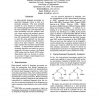Free Online Productivity Tools
i2Speak
i2Symbol
i2OCR
iTex2Img
iWeb2Print
iWeb2Shot
i2Type
iPdf2Split
iPdf2Merge
i2Bopomofo
i2Arabic
i2Style
i2Image
i2PDF
iLatex2Rtf
Sci2ools
ACL
1997
1997
A DOP Model for Semantic Interpretation
In data-oriented language processing, an annotated language corpus is used as a stochastic grammar. The most probable analysis of a new sentence is constructed by combining fragments from the corpus in the most probable way. This approach has been successfully used for syntactic analysis, using corpora with syntactic annotations such as the Penn Tree-bank. If a corpus with semantically annotated sentences is used, the same approach can also generate the most probable semantic interpretation of an input sentence. The present paper explains this semantic interpretation method. A data-oriented semantic interpretation algorithm was tested on two semantically annotated corpora: the English ATIS corpus and the Dutch OVIS corpus. Experiments show an increase in semantic accuracy if larger corpus-fragments are taken into consideration.
ACL 1997 | ACL 2007 | Probable Semantic Interpretation | Semantic Interpretation | Semantic Interpretation Method |
| Added | 01 Nov 2010 |
| Updated | 01 Nov 2010 |
| Type | Conference |
| Year | 1997 |
| Where | ACL |
| Authors | Remko Bonnema, Rens Bod, Remko Scha |
Comments (0)

